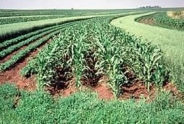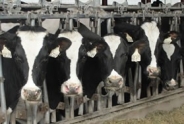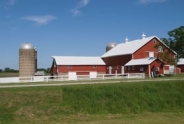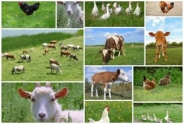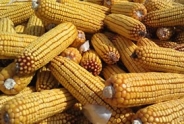Strategies for Hay Crops 2023
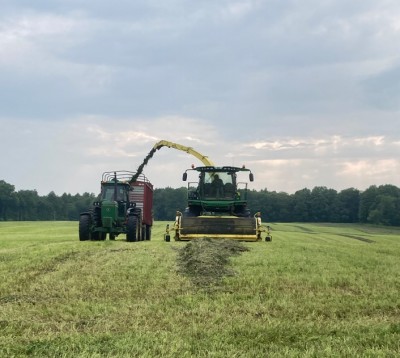
By Joe Lawrence and Kirsten Workman
The 2023 season has been a roller coaster for producing dairy quality hay crops across NYS. With widespread dry conditions throughout much of May, many experienced below average first cutting yields, though there were pockets with reports of average or better yields. There was better news on the quality front, with reports of average to above average forage quality for timely harvested first cutting being fairly uniform across the state.
With continued dry conditions through May for many, second cutting presented more frustration in decision making as yields were quite low but the crop had stagnated and was losing quality, and decisions about second cutting timing were then interrupted by rain. And while the rain was much needed, the patterns in which it was forecasted and came, created a great deal of uncertainty around windows of opportunity for cutting.
While there are always unknowns, guidelines were to "cut your losses" and harvest the second cutting to allow for the third cut regrowth to capitalize on the new moisture, as the rain would benefit the regrowth more than the stagnant second cutting. At this point, hopefully most have had an opportunity to harvest second cutting. If not, it should be taken as soon as possible.
While yields varied for both first and second cutting, for many the combined total yield is lower than desired and presents concerns about adequate inventories. With potential challenges to inventories, it is worth thinking about strategies for the remainder of the season.
Take inventory
The first step is to measure actual inventories. While we do not know what the rest of the season will bring, estimate yields for future cuttings, and compare this to the needs of your feeding program. Work with farm managers, nutritionists, and other advisors to determine these needs. The Forage acreages needed for dairy herd calculatorcan assist with these calculations.
Management of remaining cuttings
Second cutting still standing the field - Remove this material as soon as weather conditions permit. If quality is expected to be compromised by late cutting, evaluate storage options to separate this feed from higher quality forages so that it can be feed to appropriate groups of animals on the farm.
Continue to follow best management practices for harvest - when inventories are low it can be tempting to "cut corners" in harvest management, but this will often backfire.
Determine inventory needs by quality for harvest timing decisions
- If lactating quality feed inventory is still needed, stay the course with intensive cutting schedule and make plans for extra late season cuttings.
- Non-lactating quality inventory needs - with adequate rainfall, overall seasonal yields can be increased with a delayed harvest of one cutting as demonstrated in Cornell grass information sheet #20 where a three-cut system yields 15 to 25 percent greater than a four cut system. The key to this is timing of the three cuttings and what your forage quality needs are. The strategy for dairies should not be to take three cuts of mediocre quality feed. Rather, the strategy is to take two timely cuttings of higher quality forage and extend the harvest window on the third cut to increase yield. However, this is only advised if forage inventory for non-lactating animals is needed. If lactating quality feed is still needed, then cuttings should be taken in a timelier manner to capture the desired quality. It is often easier to secure lower quality forage to fill inventory gaps than it is to find high quality forage to purchase.
Cutting height
- Grass stands needs to be cut at approximately four inches to avoid stress and delayed regrowth. Do not be tempted to cut grasses lower to increase yields, this will do more damage to season long yields and quality than the potential short term yield gains from cutting lower.
- Alfalfa stands - Pure alfalfa stands can be cut lower to the ground than grass due to new growth developing from the crown of the plant, unlike grasses which regrow from the cut leaf blade. Consider field conditions, particularly risk of soil contamination on harvest equipment when determining feasible cutting height.
- Mixed stands - Cutting height will affect the grass in these stands. Consider the proportion of grass and alfalfa in these stands and future viability when determining feasible cutting height.
Retain yield and quality throughout harvest process
- Minimize time from cutting to ensiling as this will minimize respiration losses. Plant respiration after cutting decreases both dry matter (DM) yield and forage quality. The most effective practice to minimize the window from cutting to ensiling is through wide swathing. Guidelines for successful wide swathing show that the swath width needs to be a minimum of 80 percent of the cutter bar width.
- Minimize leaf loss in legumes. Much of the quality in legumes is in the leaf fraction. Harvest activities (tedding, raking, merging, harvesting) when the crop is too dry will increase leaf loss.
- Setup harvest equipment to minimize soil contamination. Consider impacts of forage cutting height and ensure handling equipment (tedders, rakes, merger, harvest pickup heads) are adjusted correctly to pick up windrow without contact with the soil surface.
- Pay attention to the details when storing hay crops. Taking care to preserve the quality of forages is even more important in challenging years. Avoid shrink with proper harvest dry matters, proper density of silos and bales, and cover and wrap adequately. View Managing for quality silage in bunk silos and piles for more information.
Maintain crop nutrition
- Nitrogen (N) on grass (through manure or fertilizer) is a staple of sound grass forage management. Typically, early season cuttings are preferred for N applications, but with adequate rainfall additional N on late season cuttings can be beneficial. The Nitrogen guidelines for field crops in NY (2023) states, "For both 3-4 and 4-5 cut systems, apply 75-100 lbs of fertilizer N per acre at green-up, followed by 50-75 lbs of N/acre after first cutting, and 50 lbs N/acre after subsequent cuttings with a maximum of 275 lbs N/acre for 4-5 cut systems. For grass that is not managed intensively (1-2 cut system), this recommendation is reduced to 75 lbs N/acre per year." There may be some unused N from earlier applications during droughty conditions, however it is difficult to quantify this.
Emergency forages
In extreme circumstances with low inventories and underperforming hay fields, it may warrant early termination of the hay crop to make room for an emergency annual forage.
- August planted oats - Oats planted by mid-August can produce good yields of high-quality forage 45-60 days after planting. For lactating quality, harvest should occur before heading during the boot stage.
- Winter cereal cover crops - planting a winter cereal such as rye or triticale on a fallow field or following corn silage can bolster forage inventories next spring. Planting should occur in early September for best results. See Agronomy Fact Sheet 56 for more specific information on establishing and harvesting winter cereals for forage harvest.
Additional resources:
- Resources for forage management in a drought situation
-Forage opportunities to combat rising costs
- Forage shrink costs more when inputs are high (2022)
- Perennial forage cutting height
- Storage strategies for over mature hay and securing extra forages
Upcoming Events
Crops, Cows & Critters - Southwest New York Dairy, Livestock & Field Crops Newsletter Sponsorship
December 19, 2025
Our two forms of publications feature research-based and timely information from our four specialists, listed to the right, along with local event notifications and Cornell University outreach. This information is provided to participants who range from dairy, livestock, and field crops producers to agricultural suppliers and consultants.
Weekly Email Update: Shared with 625+ households who have signed up with our program.
Monthly Paper Mailer: To reach our stakeholders and farmers who lack internet access, we send out a monthly mailer where your company's logo and contact information would be featured with a mailing list of 330+ households.
If you sponsor our weekly and monthly publications you reach approximately 955 households.
Visit our website to view our newsletters!
2025 Cornell Food Beverage & Animal Feed Manufacturer Survey
December 19, 2025
Industry and Educational Advocates for New York State's Food, Beverage, and Animal Feed Manufacturing industries:
As you know, NYS has a diverse food and beverage manufacturing industry, in both the types of industries that exist and the wide distribution of firms by scale. Many manufacturing firms have strong backward linkages to agricultural production sectors in the state that support both farm-level and downstream food industry firms and consumers. In collaboration with the New York State Department of Agriculture and Markets, a team from Cornell University's Charles H. Dyson School of Applied Economics and Management has recently rolled out the 2025 New York State Food, Beverage, and Animal Feed Manufacturer Survey. The industry will benefit from an updated assessment of the industry that informs private and public investments and opportunities to support firm growth and improved profitability.
Boots in the Barn: Cornell Dairy Research Updates
January 13, 2026
January 20, 2026
January 27, 2026
February 3, 2026
February 10, 2026
February 17, 2026
February 24, 2026
Join us for some or all!
Announcements
No announcements at this time.

